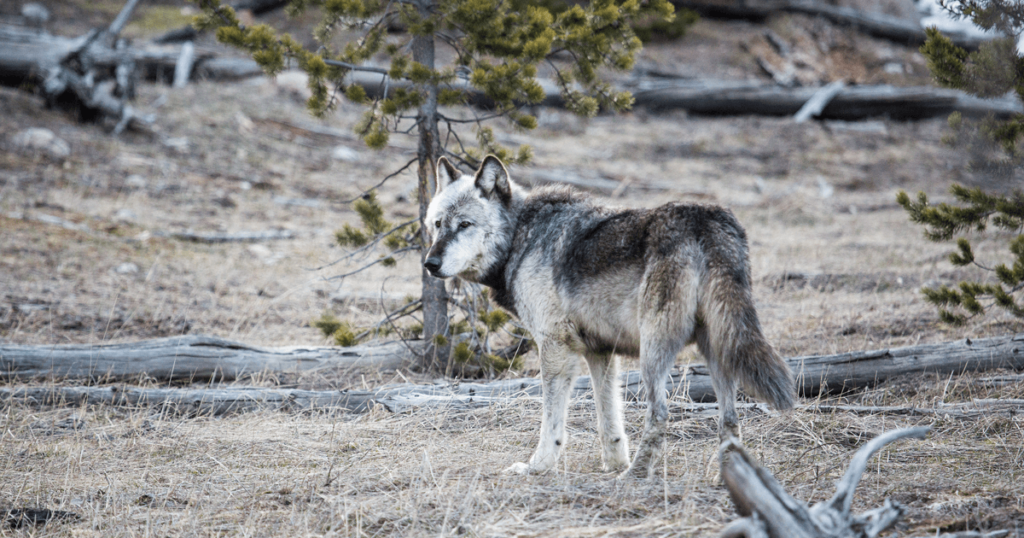
American Wolf: A True Story of Survival and Obsession in the West by Nate Blakeslee; Crown, 320 pp., $28
In Colorado several years ago, I watched Temple Grandin hand-feed dried apples to six or seven young pronghorns in a pen. They displayed none of the easy greed you see among farm animals crowding the feed bucket. There was only an incalculable reluctance, which the apples and Grandin’s preternatural composure barely overcame. These weren’t tame pronghorns or tamed pronghorns or pronghorns on their way to becoming tamed. These were captive creatures who were tolerating, for a time, the presence of the only human who could get near them. You can imagine the wildness of pronghorns when you see them at a skittish distance in the sagebrush flats of Wyoming. Looking into that pen in Colorado, I felt like I was glimpsing the force field that made them wild, as they fed, with nimble lips, on dried apples extended from Grandin’s fingers.
But is a pronghorn wilder than a beaver? Is a beaver wilder than an elk? What about an elk and a magpie? Is the prey animal wilder than the predator, or vice versa? There isn’t really a scale of wildness, and we don’t usually talk about degrees of wildness, except, metaphorically, among humans. But there’s wild, and there’s wild. The pronghorns living in the Lamar Valley are untamable, essentially alien to us by nature. And then there is the wolf. Of all the creatures living in the Greater Yellowstone Ecosystem, it is the only animal that shares the bulk of its genes with a domesticated counterpart. Gray wolves and dogs differ in their mitochondrial DNA by less than one percent—far less than the difference (six percent) between wolves and coyotes.
And yet Yellowstone became discernibly wilder when wolves were reintroduced there in 1995, having been wiped out in the 1930s. The difference wasn’t subtle. Over the next few years, animal behavior shifted up and down the food chain. Coyotes were suddenly prey animals, which allowed smaller mammals to rebound. Grizzlies began to take over wolf-kills, which was also good news for ravens. Wolves abruptly reminded elk that they were no longer cattle and pressured them out of the creek bottoms. Reintroducing wolves to Yellowstone was one of the most successful biological experiments ever performed. They bred and formed new packs and began to spread beyond the borders of the park. Within Yellowstone, the wolves have brought a kind of magical haunting, showing us how incomplete any conception of nature in the American West is when it is lacking wolves.
But to some of the ranchers who made the West safe for sheep and cattle, it was an insult. To some of the people invested in the myth of the American West, a myth of stoic independence in complete defiance of the facts, it was an outrage. To some of the elk hunters and outfitters, who were used to easy-living elk and who believed that an elk in the freezer is a God-given right, it was a betrayal. To the westerners who have forgotten the meaning of “public” in the phrase “public lands,” it was a form of trespass. And to the politicians who battened on all these overlapping cohorts, it was a kind of feast. I include Donald Trump, whose Interior Department chief, Ryan Zinke, has teamed up with the state of Wyoming in court to have gray wolves removed, within that state, from the protection of the Endangered Species Act, part and parcel of an ongoing Republican attack on almost every kind of conservation.
It needs to be made very clear that wolves are endangered only by humans who want to kill them. In the Rocky Mountain West, some people are pursuing purposeful extinction, again, using politics, the courts, disinformation, and helicopters, everything short of poisoned bait. When we talk about the sixth extinction—the great wave of extinctions now sweeping the globe—we’re usually referring to extinctions that happen thoughtlessly, accidentally, the horrific byproducts of business as usual. But the campaign against wolves is nothing less than the calculated murder of a species, and there’s hardly a politician in the states of Wyoming, Idaho, or Montana who hasn’t condoned it in one way or another. This is the look of a working myth.
Nate Blakeslee’s new book, American Wolf, is an excellent primer to the saga of Yellowstone wolves since 1995. On the surface, it’s a book about a wolf called O-Six, an alpha female born in the park in 2006 and legally murdered near a hayfield on a ranch just outside Yellowstone in 2012. Blakeslee is excruciatingly balanced in his reporting. He writes, too, as if to understand the feelings of the hunter who killed O-Six, like those who would kill most wolves, were to excuse him. Because I wrote extensively about wolf recovery for the editorial page of The New York Times, most of this story was deeply familiar to me, especially the wrangling in Congress and the courts. Perhaps that made it more apparent that American Wolf is really a book about humans, not wolves, and a book obsessed, as so many books about animals seem to be, by the nature of story itself, by the search for meaning that—so many writers feel—only story can reveal.
“Meaning” in books about animals tends to mean finding a sense of emotional connection, and if you dwell on the emotional connection between humans and animals, as this book and so many others do, you’re going to get things wrong, even if all the details are right. Blakeslee has done his homework, and he certainly knows how to build a narrative. Still, there’s something missing, and it’s not only the absence of a richer biological and evolutionary context for wolves; it’s the mythic terrain of the West itself, its illusions, its deceits, its false persuasions, which still live on as if yesterday were today.


